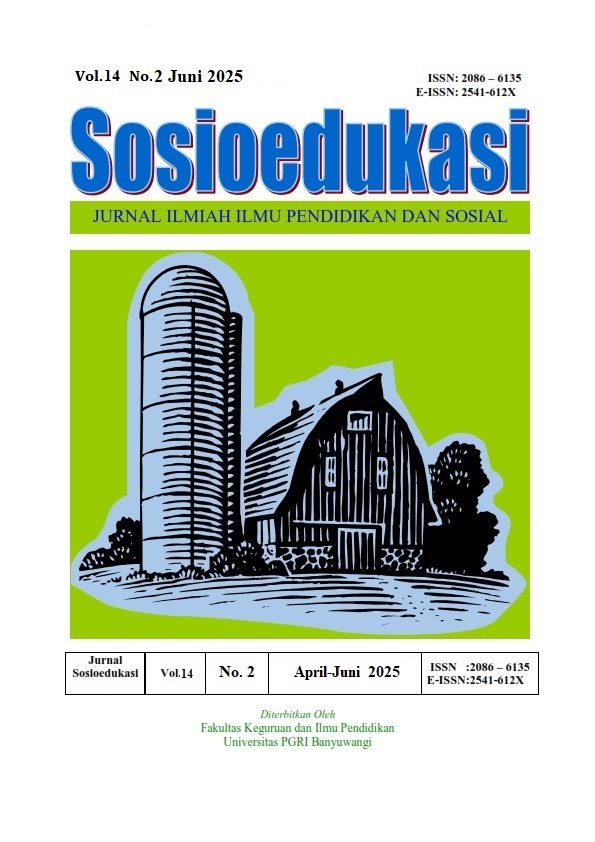URBANIZATION AND DISINTEGRATION OF LOCAL COMMUNITIES: A LITERATURE REVIEW OF THE EROSION OF SOCIAL COHESION WITHIN URBAN SPACES
URBANISASI DAN DISINTEGRASI KOMUNITAS LOKAL: TINJAUAN LITERATUR ATAS EROSI KOHESI SOSIAL DALAM RUANG KOTA
DOI:
https://doi.org/10.36526/sosioedukasi.v14i3.5719Keywords:
Urbanization, Social Cohesion, Community Disintegration, Gentrification, Inclusive Urban PlanningAbstract
Urbanization as part of the modernization process has changed the social structure and living space of people, especially in urban areas. This study aims to systematically review the literature related to the impact of urbanization on social cohesion in local communities and to analyze the dynamics of social disintegration that arise in urban spaces. The research uses a qualitative approach with a systematic literature review method, based on the perspective of critical sociology and social cohesion theory. Data is collected from scientific journal articles, academic books, research reports, and policy documents obtained through scientific databases such as Scopus, Google Scholar, and Web of Science. The analysis was carried out thematically and interpretively on the selected relevant literature published from 2017–2025. The results of the study show that urbanization triggers the erosion of communal solidarity, strengthens spatial segregation, and decreases the sense of belonging between city residents. Processes such as gentrification and social exclusion deepen inequality and marginalize traditional communities. This research confirms the importance of inclusive and participatory community-based urban planning to rebuild lost social cohesion. This study provides a conceptual basis for the development of socially just and sustainable spatial planning policiesReferences
Alia, S., & Maulana, R. Y. (2023). Sociological Perspectives on Urban Gentrification and Its Societal Implications. Journal of Current Social and Political Issues, 1(2), 72–77. https://doi.org/10.15575/JCSPI.V1I2.477
Askarizad, R., Dadashpour, A., Faghirnavaz, J., He, J., & Safari, H. (2023). Organizing worn-out neighborhoods with the new-urbanism approach using mixed methods in Rudsar, northern Iran. Smart and Sustainable Built Environment, 12(1), 128–155. https://doi.org/10.1108/SASBE-03-2021-0055
Bacaksız, S., Özsoy, İ., Teğin, T., Bıçaksız, P., & Tekeş, B. (2023). Anonymity as a Moderator of the Relationship Between FoMO (Fear of Missing Out) and Psychological Well-Being. Psychological Reports, 126(5), 2303–2321. https://doi.org/10.1177/00332941231180115
Bernstein, M. S., Monroy-Hernández, A., Harry, D., André, P., Panovich, K., & Vargas, G. (2011). 4chan and /b/: An Analysis of Anonymity and Ephemerality in a Large Online Community. Proceedings of the International AAAI Conference on Web and Social Media, 5(1), 50–57. https://doi.org/10.1609/ICWSM.V5I1.14134
Burnette, D., Ye, X., Cheng, Z., & Ruan, H. (2021). Living alone, social cohesion, and quality of life among older adults in rural and urban China: a conditional process analysis. International Psychogeriatrics, 33(5), 469–479. https://doi.org/10.1017/S1041610220001210
Calderón-Argelich, A., Anguelovski, I., Cuenca, V. C., Cole, H. V. S., Triguero-Mas, M., Valdivia, B., & Baró, F. (2024). Shifting perceptions of green and blue spaces during the COVID‐19 pandemic in gentrifying neighbourhoods: Experiences of inclusion and exclusion by women and non‐binary residents. People and Nature, 6(6), 2494–2513. https://doi.org/10.1002/PAN3.10722
Cheng, Y., Xi, J., Rosenberg, M. W., & Gao, S. (2018). Intergenerational differences in social support for the community‐living elderly in Beijing, China. Health Science Reports, 1(11). https://doi.org/10.1002/HSR2.96
Daly, P., Dias, Á., & Patuleia, M. (2021). The Impacts of Tourism on Cultural Identity on Lisbon Historic Neighbourhoods. Journal of Ethnic and Cultural Studies, 8(1), 1–25. https://doi.org/10.29333/EJECS/516
Feng, Z., Cai, H., & Zhou, W. (2020). Structural Characteristics and Spatial Patterns of the Technology Transfer Network in the Guangdong–Hong Kong–Macao Greater Bay Area. Sustainability, 12(6). https://doi.org/10.3390/SU12062204
Filazzola, A., Shrestha, N., & MacIvor, J. S. (2019). The contribution of constructed green infrastructure to urban biodiversity: A synthesis and meta‐analysis. Journal of Applied Ecology, 56(9), 2131–2143. https://doi.org/10.1111/1365-2664.13475
Glover, T. D., Todd, J., & Moyer, L. (2022). Neighborhood Walking and Social Connectedness. Frontiers in Sports and Active Living, 4. https://doi.org/10.3389/FSPOR.2022.825224
González, M. A., Prosser, S. W., Hernández-Triana, L. M., Alarcón-Elbal, P. M., Goiri, F., López, S., Ruiz-Arrondo, I., Hebert, P. D. N., & García-Pérez, A. L. (2020). Avian Feeding Preferences of Culex pipiens and Culiseta spp. Along an Urban-to-Wild Gradient in Northern Spain. Frontiers in Ecology and Evolution, 8. https://doi.org/10.3389/FEVO.2020.568835/PDF
Hadijah, Z., & Sadali, M. I. (2020). Pengaruh Urbanisasi Terhadap Penurunan Kemiskinan di Indonesia. Jurnal Wilayah Dan Lingkungan, 8(3), 290–306. https://doi.org/10.14710/JWL.8.3.290-306
Hassan, M. M., Tedong, P. A., Khir, A. M., Shari, Z., Ponrahono, Z., & Sharifudin, M. P. (2023). Reimagining Cities: Paving the Path to Happy City. International Journal of Academic Research in Business and Social Sciences, 13(10). https://doi.org/10.6007/IJARBSS/V13-I10/18818
Hochstenbach, C., & Musterd, S. (2018). Gentrification and the suburbanization of poverty: changing urban geographies through boom and bust periods. Urban Geography, 39(1), 26–53. https://doi.org/10.1080/02723638.2016.1276718
Ing, C. T., Park, M. L. N., Vegas, J. K., Haumea, S., & Kaholokula, J. K. (2023). Neighborhood level facilitators and barriers to hypertension management: A Native Hawaiian perspective. Heliyon, 9(2). https://doi.org/10.1016/J.HELIYON.2023.E13180
Ke, W., Chen, W., & Yu, Z. (2017). Uncovering Spatial Structures of Regional City Networks from Expressway Traffic Flow Data: A Case Study from Jiangsu Province, China. Sustainability, 9(9). https://doi.org/10.3390/SU9091541
Keen, M., Sanderson, D., Osborne, K., Deo, R., Faith, J., & Ride, A. (2022). Area-based approaches and urban recovery in the Pacific: lessons from Fiji, Solomon Islands and Vanuatu. Environment and Urbanization, 34(1), 151–169. https://doi.org/10.1177/09562478211072668
Keller, P. (2019). The reconstruction of privacy through law: a strategy of diminishing expectations. International Data Privacy Law, 9(3), 132–152. https://doi.org/10.1093/IDPL/IPZ012
Koohikamali, M., & Gerhart, N. (2018). Yaks versus Tweets: Sentiment Discrepancy During a Social Crisis. Proceedings of the 51st Hawaii International Conference on System Sciences, 2018-January, 1789–1796. https://doi.org/10.24251/HICSS.2018.225
Lane, J., & Lingel, J. (2022). Digital Ethnography for Sociology: Craft, Rigor, and Creativity. Qualitative Sociology, 45(3), 319–326. https://doi.org/10.1007/S11133-022-09509-3
Luoma‐aho, V. (2019). On Putnam. Public Relations and Social Theory, 194–214. https://doi.org/10.4324/9781315271231-11
Mui, Y., Headrick, G., Chien, J., Pollack, C., & Saleem, H. T. (2022). Revisiting revitalization: exploring how structural determinants moderate pathways between neighborhood change and health. International Journal for Equity in Health, 21(1). https://doi.org/10.1186/S12939-022-01771-9
Nimo-Boakye, A., & Badu-Nuamah, S. (2022). The Impact of Gentrification on Sunyani Municipality Development in Ghana. African Journal of Applied Research, 8(1), 340–350. https://doi.org/10.26437/AJAR.03.2022.22
Otrishchenko, N. (2017). (Re)defining places for community in Sykhiv housing estate. Acta Universitatis Lodziensis. Folia Geographica Socio-Oeconomica, 30. https://doi.org/10.18778/1508-1117.30.02
Polci, V., & Pierantoni, I. (2024). Innovating the Local Plan through Co-Creation and the Public Sociology Approach toward Urban Regeneration: An Italian Case Study. Sustainability, 16(8). https://doi.org/10.3390/SU16083160
Qin, Z., Tanaka, K., & Matsuoka, S. (2022). Regional disparities in bonding and bridging social capital: An empirical study of rural and urban Japan. Japanese Journal of Sociology, 31(1), 110–126. https://doi.org/10.1111/IJJS.12130
Qu, X., Qi, X., Wu, B., Yu, J., & Zhang, H. (2023). Perceived social cohesion and depressive symptoms among internal migrants in China: The mediating role of social adaptation. Frontiers in Public Health, 11. https://doi.org/10.3389/FPUBH.2023.1096318
Rhodes, C. G., Scavo, N. A., Finney, M., Fimbres-Macias, J. P., Lively, M. T., Strauss, B. H., & Hamer, G. L. (2022). Meta-Analysis of the Relative Abundance of Nuisance and Vector Mosquitoes in Urban and Blue-Green Spaces. Insects, 13(3). https://doi.org/10.3390/INSECTS13030271
Rigolon, A., & Collins, T. (2023). The green gentrification cycle. Urban Studies, 60(4), 770–785. https://doi.org/10.1177/00420980221114952
Rösner, L., & Krämer, N. C. (2016). Verbal Venting in the Social Web: Effects of Anonymity and Group Norms on Aggressive Language Use in Online Comments. Social Media + Society, 2(3). https://doi.org/10.1177/2056305116664220
Sevignani, S. (2023). “Ideology and simultaneously more than mere ideology”: On Habermas’ reflections and hypotheses on a further structural transformation of the political public sphere. Constellations, 30(1), 84–91. https://doi.org/10.1111/1467-8675.12666
Shach‐pinsly, D., & Ganor, T. (2021). A New Approach for Assessing Secure and Vulnerable Areas in Central Urban Neighborhoods Based on Social-Groups’ Analysis. Sustainability, 13(3), 1–25. https://doi.org/10.3390/SU13031174
Sharon, T., & John, N. A. (2018). Unpacking (the) secret: Anonymous social media and the impossibility of networked anonymity. New Media &Amp; Society, 20(11), 4177–4194. https://doi.org/10.1177/1461444818768547
Swartz, D. L. (2024). Book Review: On formalizing Bourdieu for urban studies & beyond Loïc Wacquant. Journal of Classical Sociology, 24(3), 295–304. https://doi.org/10.1177/1468795X241237783
Sykes, E. (2025). Power, Control, and Exclusion: The Political Dynamics Behind Urban Spaces. Sociology Compass, 19(3). https://doi.org/10.1111/SOC4.70043
Tachaudomdach, S., Upayokin, A., Kronprasert, N., & Arunotayanun, K. (2021). Quantifying Road-Network Robustness toward Flood-Resilient Transportation Systems. Sustainability, 13(6). https://doi.org/10.3390/SU13063172
Telaumbanua, E., Harsono, I., & Soegiarto, I. (2024). Urbanisation in Indonesia: The Relationship between Income Inequality, Urban Infrastructure, Access to Education, and Population Growth with Social Cohesion, Environmental Resilience, and Housing Quality to look at Urbanisation in Indonesia. International Journal of Business, Law, and Education, 5(1), 603–614. https://doi.org/10.56442/IJBLE.V5I1.443
Thurber, A., Krings, A., Martinez, L. S., & Ohmer, M. (2021). Resisting gentrification: The theoretical and practice contributions of social work. Journal of Social Work, 21(1), 26–45. https://doi.org/10.1177/1468017319861500
Trevignani, V. (2017). Cecilia Güemes (2016): Trátame suavemente. Confianza social en Latinoamérica, Argentina bajo la lupa. EUNOMÍA. Revista En Cultura De La Legalidad, 12(0). https://doi.org/10.20318/EUNOMIA.2017.3659
Wesnawa, I. G. A., Sarmita, I. M., & Christiawan, P. I. (2023). Migrant Livelihood Challenges in Peri-Urban Area. Proceedings of the 4th International Conference on Law, Social Sciences, and Education, ICLSSE 2022, 28 October 2022, Singaraja. https://doi.org/10.4108/EAI.28-10-2022.2326346
Wu, Y. (2024). The Intersection of Gender, Migration, and Urbanisation in Shaping Community Identities and Social Structures. Journal of Education, Humanities and Social Sciences, 32, 149–158. https://doi.org/10.54097/77F1H194
Yi-li, Y., & Xiang-hong, Z. (2021). Impacts of the internet on perceptions of governance at the community level: the case of Jiangqiao Township in Shanghai, China. Public Administration and Policy, 24(2), 165–181. https://doi.org/10.1108/PAP-04-2021-0026
Zhao, T., Deng, Y., Zhou, L., Wang, J., Dong, P., Yang, S., Zheng, B., Shi, J., & Wu, Z. (2024). Urbanization alters the diversity, assembly and complexity in microbial generalist and specialist community of a subtropical river system. https://doi.org/10.21203/RS.3.RS-4522061/V1









.png)

















